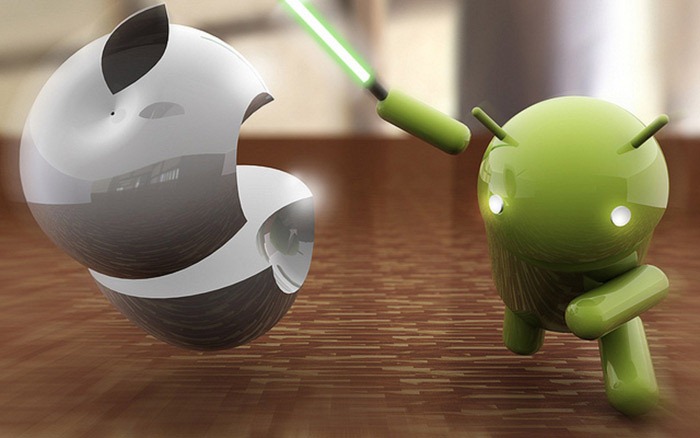Fast food in smartphones: how to earn on mobile games

Author: Grigory Kharchenko - Head of Mobile Development, Kokoc Mobile (Kokoc Group).
Smartphones and tablets burst into our lives, displacing conventional phones from it. The new generation of these devices, we appreciate for the opportunity to have fun, not just to call and send SMS. In iOS and Android, millions of applications are collected, most of which are mobile games: they account for the majority of downloads.
Gadgets covered and taught to play that part of people who had never spent time like this before. There is no clear separation by age: mobile games have mastered and loved everything from young to old. But the proportion of men playing on tablets and smartphones, a little more - 58%.
')
Most downloads of mobile games in our country are in megacities. First, in large cities, smartphones are much more widespread. Secondly, the inhabitants of megalopolises spend more time in transport, traffic jams, waiting, and they need to do something with themselves.
Contrary to popular belief, real gamers, who have been “chopping” in WoW at a stationary computer for years, reluctantly switch to gaming mobile platforms, since they do not perceive them as a serious alternative to the PC. Yes, this is one of the most solvent audiences, but she does not find what she is used to in games: depths, truly challenging tasks. Therefore, in the TOP charts of the most earning products on mobile platforms are games aimed at a different audience.
From games on stationary computers, mobiles are distinguished, first of all, by short intervals of sessions, uncomplicated plots and the absence of multifunctional control.
Cheese in a mousetrap
Developers find it difficult to predict the popularity of the new game. Sometimes it takes time to reach the TOP, sometimes it doesn't happen at all. For example, Flappy Bird, in just a few days, the Vietnamese developer Dong Nguyen wrote it. The goal of the game is to control the flight of a bird between rows of green pipes by touching the screen, without touching them. The game was released on May 24, 2013, but it became popular only in early 2014, after one of the influential bloggers wrote about Flappy Bird. In late January, it became the most downloaded free game in the App Store, at that time the developer received 50 thousand dollars a day for advertising inside the application. On February 10, Nguyen removed Flappy Bird from the App Store and Google Play, as the game became a “addictive product.” As the developer noted, according to his plan, users had to play it a few minutes during the rest.

So why create free games that then capture the minds of millions of gamers? Most often, they are released in order to earn on internal payments or advertising. There are several models of monetization.
Freemium The user does not download the whole game, but its limited demo version. For example, you have passed three levels, and the rest are closed. Or, for example, in the application there are a lot of heroes, but you are entitled to use only one for free. You can remove these restrictions by paying money.
Free-to-play. The game is downloaded for free, there are no restrictions. But users will have to spend money on convenience. For example, if you want a character to quickly recover energy - pay. Want to buy a hero new clothes - pay. Do you want to decorate the game with some rare decoration - also pay.
Advertising. This model is used to promote paid games through free. For example, you play a free application, but every time you click on a pause, you see an advertisement for another game. Or, in order to get some kind of bonus, we are forced to watch a commercial for a new paid product.
PAID. This system appeared the very first and dominated in the AppStore after the release of the first iPhone. But now even the developers of such unique products as city maps are forced to abandon PAID, since they cannot compete with applications that do not require money for downloading.
Expensive and angry
It takes at least a year to develop a truly good game, and its production costs at least 300 thousand dollars, because at the time of release it should contain content that is enough for at least a couple of months of the process with an active game.
But releasing the game is only the first step. Even at the testing stage, developers cannot “clean out” all errors from their product. And identify them, most often, the users who first downloaded the application. In the process of testing, developers donate an audience that can be lost without harming the business. Especially attentively they approach the choice of the country whose residents are the first to download the game. No developer will launch an unverified game in the US or Japan, as these are the two largest markets with the highest consumer activity. Therefore, countries are selected with a significantly smaller number of people, but close in mentality to the leaders. For example, Canada, New Zealand.
Another important point is the operating system. Android or iOS? Companies with large budgets are guided by both options, and developers are easier to choose Android. First, applications for this platform are written in the more common Java programming language, and, second, there is no pre-release moderation on it. Before you get into the App Store, the game is tested for a long time, and on Google Play, applications are considered after the fact. In addition, the Android developer license is cheaper - $ 25, instead of $ 100 on iOS. But Android also has its drawbacks. For example, the process of testing an application requires a lot of time and money. This operating system is on many smartphones and tablets, so developers have to take into account the different screen diameters.

Games for iOS are written in the Objective-C programming language, which far from every developer knows, and it should be created on Apple devices. But there are advantages to these limitations - although there are fewer games on iOS than on Google Play, their quality is higher.
Millions of billions
At the dawn of the mobile gaming market, users downloaded any applications. For example, a badly drawn face appeared on the screen, a pimple popped out on it every few seconds, which had to be squeezed out. At the same time, no points were awarded in the game, no winners were revealed. It would seem, how can you play it? But even this application was popular. It was at that time that the current market giants appeared, one of them is the game Angry Birds. Now it has become a proven brand, and each application released under his name becomes a hit.
Today there is high competition in the mobile games market. Users download only those products that are in the TOP of the App Store and Google Play, and it is extremely difficult to get there. For example, in order for the game to enter the TOP 10 App Store in Russia, about 10 thousand people must download it daily. Therefore, developers have to seek help from ad networks, such as TapJoy, which install advertisements in free games. Downloading a game by one user costs an average of $ 3. It turns out that not only end users pay for the game, but also its creators who need to do everything so that they can see the product. Often, before the release of the new game, a large-scale advertising campaign is organized: users are notified about the release on social networks, reviews of well-known bloggers, and sometimes even on TV channels.
People says

Kirill - head of department in a large company:
- spends at least 450 rubles on games per month;
- Daily plays no more than 7 minutes.
I often download mobile games, although there is almost no time for them. Usually I choose either the highest-grossing ones, or those that my friends recommended to me or that they write about in influential reviews. For me it is not critical, paid game or not. Moreover, I think that you need to pay for the games - this is a way to say “thank you” to the developers.
Maria - event manager:
- spends no more than 40 rubles on games for a month;
- Daily plays about 20 minutes.
I have to travel a long time from home to work and back. Therefore, mobile games - a way to quietly spend this time. But I consider it pointless to spend money on them: why, when there are millions of absolutely free, but interesting applications. Therefore, when I search for a new game, then, first of all, I enter it in “TOP-free”. Of course, sometimes you get a really cool paid game that you don’t mind spending money on.
Evgenia - PR-manager:
- spends about 100 rubles on games per month;
- plays about 30 minutes daily.
In the smartphone I play when I go home from work. The genre of the game is not so important, but most of all I like logic games: for example, to complete a quest or solve a complex puzzle. I am looking for games through TOPs, and if the application is like it, then I’m wondering if its developers have released anything else interesting. I prefer to download free games. But if after the demo version I want to continue playing them, I can spend the money.
Reference:
At the end of 2014, the turnover of the global mobile gaming market increased from 17.7 to 21.1 billion dollars, reports the website VentureBeat, referring to the report of the company SuperData. More than half of the revenue from mobile games, including micropayments and advertising in them, comes from the Asian region ($ 11.3 billion). North America is in second place ($ 3.8 billion), Europe is in third place ($ 3.4 billion), Latin America is in fourth place ($ 1.8 billion). The rest of the world has $ 0.8 billion.
SuperData experts calculated that most people in the US and the UK spend on mobile games: this year alone they spent an average of $ 25 per month. For comparison, the people of Russia spend on mobile games a little less than $ 20 a month.
It is projected that in 2016 worldwide mobile games will collect 28.2 billion dollars. The Chinese market is considered to be the most promising: SuperData analysts rated the audience of mobile games in China at 266 million people, and in the United States at 242 million people. At the same time, Android dominates the Asian market, while Americans prefer iOS.
According to Newzoo and Mail.Ru Group, 33.8 million people play mobile games in Russia. In recent years (from 2010 to 2013), the volume of the mobile games market in our country has grown more than 9 times and amounted to 165 million dollars (in 2010 the share of mobile games in the online segment was only 5% - 18 million dollars). By 2016, the audience of mobile games in Russia will be about 65 million people, Digit.ru refers to the forecast of analysts of the Ericsson Comsumer Lab.
Source: https://habr.com/ru/post/293918/
All Articles